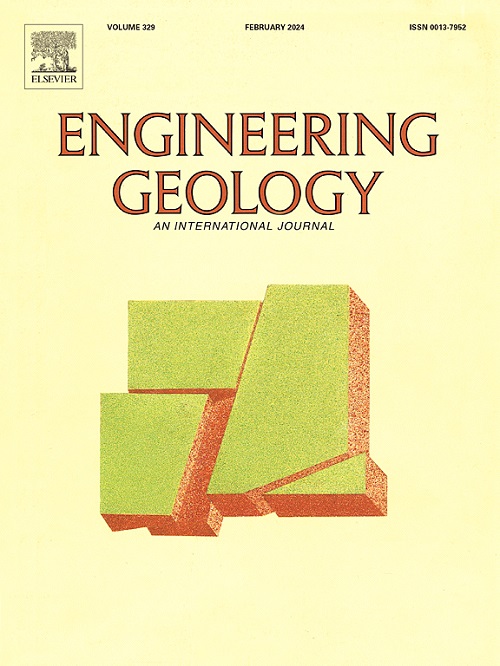气候驱动河谷冰川运动的热-水-力耦合分析模型(THM-GA 1.0)
IF 8.4
1区 工程技术
Q1 ENGINEERING, GEOLOGICAL
引用次数: 0
摘要
在世界范围内观测到一个奇异现象:多个山谷冰川(体积>;以前被认为稳定的缓坡(~ 10°),现在正在加速甚至不稳定。这一问题背后的机制仍未被完全理解,由于所涉及的多物理过程的复杂性,缺乏预测模型。本研究建立了一个热-水-力耦合冰川分析模型(THM-GA 1.0),用于分析气候驱动的冰川运动。该模型的独特特征是流体力学反馈和冰川动力学与碎片-冰混合物的热力学行为耦合。通过3次基准试验对模型进行了验证,并以藏东南雅鲁藏布江大峡谷的世东堡冰川(29.80°N, 94.92°E)为例进行了实际验证。结果表明,气候变暖增强了季节变化与冰川动态之间复杂的相互作用。冰川内部的多热结构促进了长期的不均匀运动,促进了裂缝的扩展和水的渗透。软质可变形冰川床的入渗水提高了基底孔水压力,降低了基底滑动阻力,加速了冰川运动或失稳。我们的研究结果表明,前所未有的低角度冰川运动的增加归因于温度引起的裂缝扩展和基础水文之间的相互反馈。这项研究有助于理解气候驱动的冰川运动和减轻冰川危害。本文章由计算机程序翻译,如有差异,请以英文原文为准。

A thermal-hydro-mechanical coupled analysis model for climate-driven movements of valley glaciers (THM-GA 1.0)
A singular phenomenon was observed worldwide: multiple valley glaciers (volume > 106 m3) on gentle slopes (∼10°), previously considered stable, are now accelerating or even destabilizing. The mechanisms behind this issue remain not fully understood, and prediction models are lacking due to the complex nature of the multi-physical processes involved. This study develops a coupled thermo-hydro-mechanical glacier analysis model (THM-GA 1.0) to analyze climate-driven glacier motions. The unique features of the proposed model are hydro-mechanical feedback and glacier dynamics coupled with the thermomechanical behavior of debris-ice mixtures. The model is verified by three benchmark tests and applied to analyze the Sedongpu glacier (29.80°N, 94.92°E) in Yarlung Tsangpo Grand Canyon, Southeast Tibet, serving as a real-world validation case. Results show that the warming climate enhances the intricate interplay between seasonal variations and glacier dynamics. The polythermal structure within glaciers fosters long-term non-uniform movements, facilitating crevasse propagation and water infiltration. The infiltrated water in the soft and deformable glacial bed elevates basal pore-water pressure, reduces basal sliding resistance, and accelerates glacier movements or destabilization. Our findings reveal that the unprecedented increased low-angle glacier movements are attributed to the mutual feedback between temperature-induced crevasse propagation and basal hydrology. This study contributes to understanding climate-driven glacier movements and mitigating glacier hazards.
求助全文
通过发布文献求助,成功后即可免费获取论文全文。
去求助
来源期刊

Engineering Geology
地学-地球科学综合
CiteScore
13.70
自引率
12.20%
发文量
327
审稿时长
5.6 months
期刊介绍:
Engineering Geology, an international interdisciplinary journal, serves as a bridge between earth sciences and engineering, focusing on geological and geotechnical engineering. It welcomes studies with relevance to engineering, environmental concerns, and safety, catering to engineering geologists with backgrounds in geology or civil/mining engineering. Topics include applied geomorphology, structural geology, geophysics, geochemistry, environmental geology, hydrogeology, land use planning, natural hazards, remote sensing, soil and rock mechanics, and applied geotechnical engineering. The journal provides a platform for research at the intersection of geology and engineering disciplines.
 求助内容:
求助内容: 应助结果提醒方式:
应助结果提醒方式:


